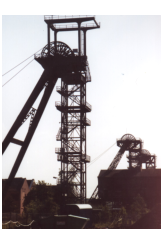







History of Hamm
In 1226 the “Earl Adolf von der Mark” founded Hamm. The inhabitants came from “Nienbruegge”, a
nearby town that had recently been destroyed.
The name of the city has its origin in the ancient field-name "Ham", meaning "angle". It was in the
angle formed by the two rivers “Lippe” and “Ahse”.
Hamm developed rapidly as it was awarded the rights of own coin as well as own measures, and because it had an
excellent, strategic and geo graphical location in the junction of old trade routes at the “Lippe” crossing. Hamm became
the residence of the Earls of Mark. Being the principal among the Mark towns it became a member of the Hanse League
- a middle age trade organization - between 1469 and 1651.
The structure of the city of Hamm was changed decisively in the 17th century by plague, fires, wars, the decline of the
Hanseatic League and with that the municipal Patriarchs.
In 1767, the "Count's chamber deputation" established as an independent state authority.
In 1787 Hamm was a separate war- and domain-chamber with the chamber-president “Freiherr vom Stein” (1788-1796).
The Napoleonic period brought billeting, hard taxes for the occupying forces and the incorporation into the Grand Duchy
Berg. After elimination of the French power Hamm was incorporated into the region Arnsberg of the newly-created
province “Westphalia”. In 1820 the movement of the “Appeal Court” by cabinet order of the Prussian King Friedrich
Wilhelm III of Kleve to Hamm became important. The “Appeal Court” is today's “Higher Regional Court” in Hamm.
The construction of the Cologne-Minden railway (1847) with the intersecting railway line Paderborn-Münster (1850) laid
the foundation for industrial and mining city of Hamm with a thriving wire and machine-building industry.
On the 1st of April Hamm left the county and became administrative district in its own right.
Since 1901 the city of Hamm and neighboring communities have been strongly influenced by
coal mines as “Heinrich Robert” (Pelkum), “Maximilian” (Werries) “Radbod” (Bockum-Hövel),
“Sachsen” (Heessen). In 2010 the last shift was driven in Hamm and the output of coal was
closed at a coalmine.
The city of Hamm was already an important
German railway junction - at times the greatest in Europe - and
industrial location (e.g. the wire industry) also in the forties. For this
reason Hamm was aim of the most intense bomb raids in the 2nd World
War on a town of the Ruhr district. The living stock of the city of Hamm
was destroyed approximately to 60 per cent. Churches like the
“Pauluskirche” or “Liebfrauenkirche” did not escape either.
After the war you immediately started with the reconstruction. The
tramway traffic was resumed on June 15th, 1945. Tramways in Hamm
existed already since 1899. Due to economic considerations the tramway
service was switched to bus traffic as of April 1st, 1961.
The town developed among others by two municipal reorganizations 1968 and 1975 under association of the town centre
with Bockum-Hövel, Heessen, Herringen, Pelkum, Rhynern and Uentrop into an efficient city.




Colliery Radbod
St. Paul's Church (without tower until 1959)
Trams 1956, at today’s Town Hall
Hamm’s oldest coat-of- arm above the entrance to
arm above the entrance to comminittee room of the
comminittee room of the town hall.
town hall.
 arm above the entrance to
arm above the entrance to comminittee room of the
comminittee room of the town hall.
town hall.








